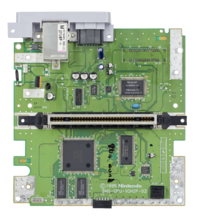SNES:Buying Guide: Difference between revisions
| Line 31: | Line 31: | ||
|| (image needed) || SNS-CPU-RGB-01/02 || 1994-1995 || NTSC || Has simplified video circuitry. | || (image needed) || SNS-CPU-RGB-01/02 || 1994-1995 || NTSC || Has simplified video circuitry. | ||
|- | |- | ||
|| | || [[Image:Snesapuboard.png|200px]] || SNS-CPU-APU-01 || 1995 || NTSC || Consolidates most of the sound hardware into a single chip, the S-APU. '''Has video quality issues through RGB due to a poorly routed color subcarrier trace.''' '''Last of the 2-chip/3-chip boards.''' | ||
|- | |- | ||
|| | || [[Image:1chip02.png|200px]] || SNS-CPU-1CHIP-01/02/03 || 1995-1996 || NTSC || Consolidates the CPU, PPU1 and PPU2 into a single ASIC. Video quality is considerably sharper but is also overly bright and has some slight ghosting. Also has compatibility issues with several games. The -03 revision does not have the circuitry for composite sync populated. | ||
|- | |- | ||
|| (image needed) || SNSP-CPU-1CHIP-01/02 || 1995-1996 || PAL || PAL version of the 1CHIP. | || (image needed) || SNSP-CPU-1CHIP-01/02 || 1995-1996 || PAL || PAL version of the 1CHIP. | ||
Revision as of 18:31, 11 February 2024
There are two major variants of the SNES and Super Famicom, with the original model having a number of different revisions. This buying guide serves to delineate the differences between these revisions and briefly explain what to look for when adding an SNES or Super Famicom to your setup.
Original Model (SNS-001/SNSP-001/SHVC-001)
- Released in the following regions:
- Japan: November 1990
- North America: August 1991
- PAL regions: 1992
- South Korea: 1992
- Brazil: August 1993
- Has two major cosmetic designs, a rounded one which was used in Japan, Korea and PAL territories, and a more rectangular design used in North America and Brazil
- Outputs composite video, S-video, RGB and stereo audio from a custom multiout connector
- All except French models also have RF output
- The power input jack differs between regions:
- Super Famicom consoles take a 5.5 x 2.1 mm barrel jack with tip negative polarity, power supply specifications are the same as the original Famicom (9V DC, 850 mA)
- US SNES consoles take a 6.9 x 4.1 mm barrel jack with a center pin and tip negative polarity. Specifications are 9V DC, 850 mA
- PAL SNES consoles take a 5.5 x 2.5 mm barrel jack, power supply specifications are the same as the PAL NES (9V AC, 1.3 A)
- Earlier US SNES consoles and all PAL and JP consoles have a cartridge lock mechanism designed to prevent cartridges being removed while the console is powered on
Board Revisions
Nintendo produced many revisions of the model 1, with each revision consolidating chips and/or circuitry to reduce production costs.
A word about the SHVC-CPU-01
Consoles with an SHVC-CPU-01 board revision have serious longevity concerns, as an increasing number of these consoles are experiencing chip failures. These failures usually afflict the CPU and/or both PPUs, and manifest as issues such as corrupted graphics, booting only certain games, or controllers not working. In addition, these consoles are also beginning to suffer from leaky capacitors, which can cause various problems and can damage the board if not rectified in time. Because of these growing problems, consoles with an SHVC-CPU-01 board are not recommended, especially if they are being sold as "untested". Thankfully, these revisions are easily discerned by looking at the bottom of the console. If it has four rubber feet on the bottom, it will have an SHVC-CPU-01 board. All later board revisions only have two rubber feet at the front. If you do decide to purchase an SHVC-CPU-01 console, make absolutely sure it is fully tested and if possible, run the SNES Burn-In Test to ensure the console is actually functioning properly.
New-Style SNES/Super Famicom Jr.
- Only released in North America (October 1997) and Japan (January 1998)

